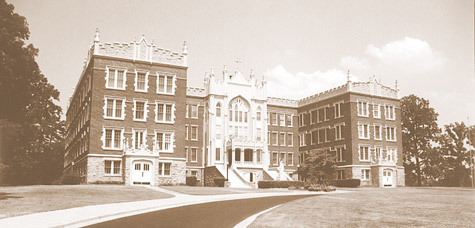

One of the most important events in the history of the Vatican and Italy occurred on Feb. 11, 1929. With the signing of the agreement between Pope Pius XI and King Emmanuel III of Italy, the Vatican and Italy finally recognized each other as sovereign nations.
Click here |
How did this story affect American Catholics? Apparently with the new Vatican city state, some people in the United States began to question the citizenship of 20 million American Catholics.
Many opponents of the Catholic Church felt American Catholics would have a divided allegiance. They said no one could have allegiance to the Vatican and America at the same time. A Catholic Extension magazine editorial answered these claims, daring the opponents to bring a bill before Congress to settle the question.
Congress was also urged to continue to not recognize the sovereignty of the Vatican.
In October 1929, it was reported that the pope had 530 "subjects," which included "389 Italians, 118 Swiss guards, 11 Frenchmen, five Germans, two Spaniards and one Norwegian, Austrian, Netherland and Ethiopian." Only one American is listed.
A historic day occurred Dec. 20, 1929, when Pope Pius secretly celebrated Mass at the Basilica of St. John Lateran. It was his 50th anniversary as a priest, but it was also the first time that a pope had been in the city of Rome since 1870. He was finally able to extend his pastoral ministry to Rome.
Seminary moves, CHS opens
In the July 19, 1930 issue, it was reported that St. John Seminary was moving to the Little Rock College buildings in Pulaski Heights. At the same time in the fall "Morris Preparatory" would open at the former seminary location on 25th and State streets in downtown Little Rock as a free Catholic school for boys with Father John J. Healy as its leader.
Bishop Morris explained that the seminary needed to move to handle its growing enrollment. The school not only served to educate priests for the Diocese of Little Rock, but it also helped educate men for other southern dioceses. Since the seminary opened in 1911, it has educated 66 percent of the current priests in Arkansas.
At the same time it was reported that Little Rock College, which offered four-year degrees in arts, science, philosophy, pre-medical and pre-law in addition to a pharmacy degree, would continue to operate alongside the seminary. When the boys' high school opened in the fall, it was officially called Catholic High School.
Persecution in Mexico
In February 1929 the Mexican government started to crack down even harder on the Church. All priests were required to register their address with the government. If they did not, the government would consider that they were active in the "religious movement against the federal government."
Because Plutarco Elias Calles could not run for re-election in November 1928 and his successor was murdered, Calles arranged for himself to become the "political chief" of the country and later minister of war while Emilio Portes Gill was elected the provisional president.
In the June 29, 1929 issue, the end of the religious war was reported. Under the headline "Mexican religious peace pact signed," an article from NCWC News Service proclaimed that religious peace would return to the country. Dwight W. Morris, U.S. ambassador to Mexico, was instrumental in negotiating the agreement after talks broke down between Gill and Archbishop Leopoldo Ruiz Flores, apostolic delegate.
Rise of Father Sheen
Father Fulton J. Sheen, professor of religion at Catholic University and host of "Catholic Hour" on radio station WEAF, was becoming more popular. His columns began to appear in the pages of The Guardian and reports of what he said on his radio programs were detailed. Each issue of The Guardian provided a log by the minute of what the radio show would broadcast, including a 20-minute talk by Father Sheen and 10 minutes of questions and answers. (Father Sheen became a popular television host of "Life Is Worth Living" in the 1950s. He was named an auxiliary bishop in 1951, bishop in 1966 and an archbishop in 1969.)
The Depression
When the stock market crashed in October 1929, The Guardian didn't mention the occurrence. It wasn't until two years later in October 1931 that the subject of unemployment was mentioned specifically. "Holy Father pleads for charity toward the victims of Depression," the front page headline read. The apostolic letter on unemployment showed particular concern for children, "the humble and less monied, the workers and the proletariat."
Next week: Stories from 1932-1934
Headlines
1929
Bishop's pastoral letter makes stirring appeal for enthusiastic missionary endeavor by priest and people throughout the diocese.
Bishop of the Arctic Circle sends pope skin of polar bear
New Catholic church for colored to be formally opened Sunday; school classes begin next week
1930
Bishop invests six priests with honors of monsignori
U.S. will be ruined by divorce, archbishop states in pastoral
The bishop ordains largest class in history of St. John Seminary; nine young men raised to priesthood
Altus man has notable success growing grapes
1931
Einstein deals blow to claim he is atheist
Fire totally destroys church at Weiner, Ark.
Holy Father's broadcast, first in history, is heard by record radio audience
First communion class of Mexican children at Bauxite, Arkansas
Gandhi disclaims any intention to oust the clergy
Young priest is home for his first solemn Mass. Rev. Frank Allen, third native of the Cathedral Parish to be ordained, returns to Little Rock on completing his studies at Rome
AdvertisingRalph Robinson & Son, funeral directors and embalmers, Pine Bluff, Ark.
Little Rock Gas and Fuel Company: In the spring the housewife's fancy turns to hot water. The American Ace gives you hot water 24 hours a day, assures you of cleanliness so necessary to health and happiness
Porbeck Printing Co.: Try us on your next printing
The 1930 Nash 400: "The most wonderful car I ever have driven." Twin-ignition eight, priced from $1,625 to $2,260.
Please read our Comments Policy before posting.
Article comments powered by Disqus St. Paul says: How does the Bible define love?
St. Paul says: How does the Bible define love?
 6 steps to getting married in Diocese of Little Rock
6 steps to getting married in Diocese of Little Rock
 Most frequently asked questions on Catholic marriage
Most frequently asked questions on Catholic marriage
 St. Timothy winner recommends adoration to other teens
St. Timothy winner recommends adoration to other teens
 St. Joseph a model of solidarity with immigrants
St. Joseph a model of solidarity with immigrants
 Two gifts after Jesus’ death: Virgin Mary and Eucharist
Two gifts after Jesus’ death: Virgin Mary and Eucharist
 Why we have an altar, and not just a communion table
Why we have an altar, and not just a communion table
 Pope: Wars should be resolved through nonviolence
Pope: Wars should be resolved through nonviolence
 Living relationship with Jesus Christ in the Eucharist
Living relationship with Jesus Christ in the Eucharist